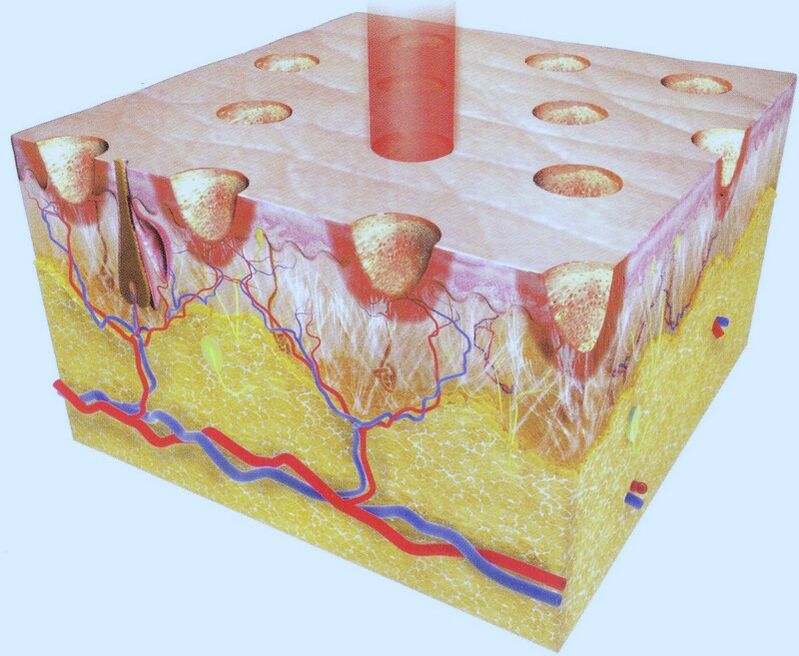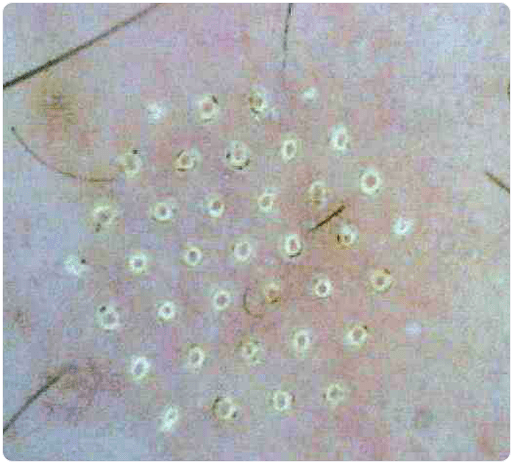
A variety of hardware techniques and non-hardware procedures are used in modern medicine today to solve the problems of young and aging skin, but you shouldn't confuse Photo and Elos rejuvenation procedures with fractional rejuvenation - fractional thermolysis.
Fractional thermolysis is a controlled, effective and safe method of rejuvenating and eliminating various cosmetic imperfections with a laser, suitable for both aging and young skin. In operation, a laser beam is created as thick as a human hair. For a flash with a size of 1-1. 5 cm² the laser "pierces" many micro-wounds (laser micro-incisions) in the skin. Around each of them remain untouched areas and damage caused by laser pulses give an impulse to restore the skin structure over the entire treated surface.
Look at the technology for yourself. The "fractional" ablative (ablative) tapering interacts closely with the "traditional" one in which the fractional ablative (ablative) tapering alternates with untreated microthermal damage zones (MTZ) due to its "point" radiationTissue generated. As a result, healing is much faster (just 1-2 days), which allows you to get back to your normal lifestyle immediately.
The job of the laser is to destroy tiny bits of the old collagen and elastin, and the cells preserved around the affected areas "wake up" and begin to intensively reconstruct the damaged area. Recycled collagen and elastin as well as other proteins are involved in tissue regeneration and are coagulated by the laser in the affected area. The result is a new, functionally active skin with all the characteristics of a youthful one.
The therapeutic effect is determined by the location of microscopic areas on the skin.
Exposure areas: face (including upper and lower eyelids, crow's feet), forehead, brow region, temple region, cheeks, nose, nasolabial triangle, chin, neck, cleavage, hands, forearms, mammary glands, abdomen, back, thighs, buttocks region and other areas.
Fractional thermolysis enables:
- achieve a rejuvenating effect on the skin of the face, neck, décolleté, back of the hand;
- remove wrinkles in the delicate and delicate area of the eyes ("crow's feet");
- Eliminate age spots (increased pigmentation, melasma);
- clearly smooth, postoperative and traumatic (after cuts and burns) scars until they have completely disappeared;
- Combat stretch marks on the skin;
- correct the effects of acne (post acne);
- decreased skin tone;
- an alternative to deep chemical peels.

How does the procedure work? Before starting the treatment, the skin is cleansed with an antiseptic. The doctor sets the parameters required to operate the laser.
Fractional thermolysis is carried out directly with the help of a special attachment that makes it possible to maintain the same distance from the "beginning" of the light beam to the skin.
During the session, the "flash" of the laser gives you a sensation that is comparable to a tingling sensation. The procedure ends with the application of a nourishing, soothing cream.
The length of the session and the number of procedures depend on the area treated and the problem to be solved.
After the procedure, the rehabilitation time is minimal. The rapid re-epithelialization process ensures the restoration of the epidermal barrier, the reduction of erythema and immediate clinical results (tissue "tightening" due to the selective parameters of thermal radiation). The tissue reaction in the form of slight edema and reddening of the skin lasts for one to two daysThis procedure will remove naturally occurring flaking with light scrubs and moisturizers.
In order for the rehabilitation phase to proceed without complications and for the result to last for a long time, all the doctor's instructions for caring for sensitive skin at home must be followed!
Contraindications to fractional thermolysis
- Pregnancy.
- Epilepsy.
- Oncological diseases.
- Acute inflammatory skin diseases.
- Herpes in the active phase;
- Psoriasis.
- Atopic dermatitis in the acute stage.
- Inflammatory processes in the area of the proposed treatment.
- If less than 2 weeks have passed after chemical peels and similar procedures.
- If less than 2 weeks have passed since the last tanning session.


























